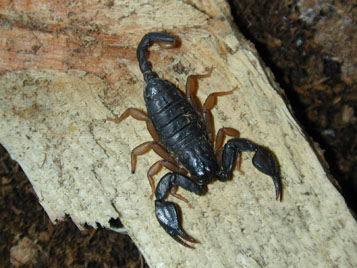Euscorpius flavicaudis |
||
|
|
|
Common names:
All Euscorpius were previously placed in
the family Chactidae.
Distribution:
Africa (Algeria, Tunisia), Europe (France, Italy, Spain).
Introduced to Great Britain and Uruguay (South America).
Habitat:
Warm, temperate climate in South-Western Europe. It is
found in different habitats (in gardens, under stones, in
houses, in old walls).
The species in not uncommon in human habitations. In
Great Britain, the scorpion occupies cracks and holes in
walls where the mortar pointing has crumbled away. Data on natural habitats in Southern
Europe wanted!
Venom:
Few medical data available, but data from Italy suggest local effects only. Mildly
venomous. Harmless scorpion, which rarely will use its
stinger. According to Dr. Tim Benton, the sting is less than
a pin-prick to humans.
Selected litterature:
Cloudsley-Thompson, J. L. (1958). "Notes on
arachnida, 30: Scorpions in England." Ent. Mon. Mag.,
vol. 94, p. 229.
Wanless, F.R. (1977). On the occurrence of the
scorpion Euscorpius flavicaudis (Degeer) at
Sheerness Port, Isle of Sheppey, Kent. Bull. Br.
arachnol. Soc., vol. 4 (2), pp. 74-76
Hawkins, K.M. (1982). Another record of Euscorpius
flavicaudis (De Geer) in Essex. Newsl. Br. arachnol.
Soc., vol. 34, pp. 6-7.
Cloudsley-Thompson, J. L. and C. Constantinou (1983).
"How does the scorpion Euscorpius flavicaudis
(Deg.) manage to survive in Britain." Int. J.
Biometeor., vol. 27(2), pp. 87-92.
Carricaburu, P. and Munoz-Cuevas, A. (1986). Spontaneous
electrical activity of the subesophageal ganglion and
circadian rhythms in scorpions. Experimental Biology (Berlin),
vol. 45(4), pp. 301-310.
Ugolini, A et al. (1986). Mother-young relationship in Euscorpius:
Adaptive value of the larval permanence on the mother's
back (Scorpiones, Chactidae). J. Arachnol., vol. 14(1),
pp. 43-46.
Torregiani, F. & C. La Cavera (1990). Puntura di scorpione
(Euscorpius, sp.) in Italia e rassegna dello scorpionismo
[Scorpion sting (Euscorpius, sp.) in Italy and scorpionism review.]
Minerva Medica, vol. 81 (suppl. 2), pp. 137-145.
Benton, T. G. (1991). "The life history of Euscorpius
flavicaudis (Scorpiones, Chactidae)." The
Journal of Arachnology, vol.19, pp. 105-110.
Benton, T. G. (1991). "Reproduction and parental
care in the scorpion Euscorpius flavicaudis."
Behaviour, vol. 117, pp. 20-25.
Benton, T. G. (1992). "Determinants of male mating
success in a scorpion." Animal behavior, vol. 43,
pp. 125-135.
Benton, T. G. (1992). "The ecology of the scorpion Euscorpius
flavicaudis in England." J. Zool. London, vol.
226(3), pp. 351-368.
Benton, T. G. (1992). "Scorpions in a cold
climate." New Scientist, vol. 134(1821). p. 15.
Benton, T. G. (1993). The reproductive ecology of Euscorpius
flavicaudis in England.
Memoirs-of-the-Queensland-Museum, vol. 33 (2), pp.
455-460.
Benton, T.G. (1993). Courtship behaviour of the scorpion,
Euscorpius flavicaudis. Bull. Br. arachnol. Soc.,
vol. 9 (5), pp. 137-141.
Crucitti, P. (1993). Distribution and diversity of
Italian scorpions. REDIA, vol. LXXVI (2), pp. 281-300.
Toscano-Gadea, C.A. (1998). Euscorpius flavicaudis
(Degeer, 1778) in Uruguay: First Record from the New
World. Newsl. Br. arachnol. Soc., vol. 81, p. 6.
On the Internet:
Online identification key for Euscorpius
European
scorpions (Dr. Benjamin Gantenbein).
Euscorpius
flavicaudis - a swedish scorpion? Article in swedish.
French
article on E. flavicaudis
General:
This species is a small black scorpion with yellow-brown
legs and sting (telson). Adults measure 35-45 mm. It is a
typical fossorial scorpion with large, strong pedipalps,
a stout body, short legs and a short, thin tail
(metasoma). See the Euscorpius identification key for more details.
This species is kept in captivity (especially in Europe), but not as coomon as should be espected from a "native" scorpion. Few commersial suppliers deliver this species (and other Euscorpius).
Euscorpius flavicaudis photo by Jan Ove Rein (C)
